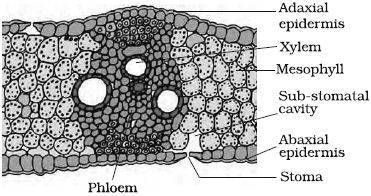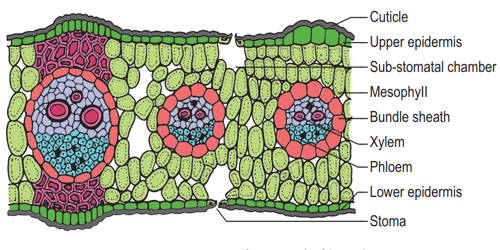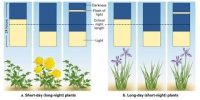The anatomy of an isobilateral leaf or monocotyledonous leaf is similar to that of the dorsiventral leaf in many ways. It is made up of either only spongy or palisade parenchyma cells. It shows the following characteristic differences. In an isobilateral leaf, the stomata are present on both the surfaces of the epidermis; and the mesophyll is not differentiated into palisade and spongy parenchyma (Figure). These types of leaves are similar in appearance on both sides and hence, are called an isobilateral type of leaves.

These types of leaves are found in grasses and monocots e.g., maize. In grasses, certain adaxial epidermal cells along the veins modify themselves into large, empty. colorless cells. Most leaves have certain common features like a covering of an epidermal layer on each surface. These are called bulliform cells. When the bullifon cells in the leaves have absorbed water and are turgid, the leaf surface is exposed. When they are flaccid due to water stress, they make the leaves curl inwards to minimize water loss. The parallel venation in monocot leaves is reflected in the near similar sizes of vascular bundles (except in main veins) as seen in vertical sections of the leaves. The ground tissue that occurs between the two epidermal layers is called mesophyll. Vascular bundles, generally known as veins, are embedded in the mesophyll. The organization and characteristics of each of these layers differ significantly for dorsiventral and isobilateral leaves.
Based on the approach of course to the main axis of plant and direction of sunlight, leaves in angiosperms can be divided into two types
Dorsi-ventral leaves – These leaves orient themselves at an angle to the major axis and vertical to the direction of sunlight. Most dicots have dorsiventral leaves that are net-veined, including most trees, bushes, garden plants and wildflowers.
Isobilateral leaves – These leaves orient themselves parallel to the major axis and parallel to the direction of sunlight. Most monocots possess parallel-veined isobilateral leaves, including grasses and grasslike plants, lilies, irises, amaryllises, etc.
Internal Structure of Monocot or Isobilateral Leaf –
- Epidermis: Monocot leaf has upper and lower epidermis. The epidermis is made up of parenchyma cells. The Cuticle is present on the outer wall stomata are present on both upper and lower epidermis.
- Mesophyll: It is the ground tissue that is present between both epidermal layers. The Mesophyll is not differentiated into palisade and spongy parenchyma. These cells contain chloroplasts.
- Vascular bundles: large numbers of vascular bundles are present, some of which are small and some are large. These are conjoint, collateral and closed. Xylem is present towards upper epidermis and phloem towards the lower epidermis.
Diagnostic Features of Isobilateral Leaf –
- Two epidermal layers
- The Cuticle is present on both epidermal layers
- Motor Cells present in the upper epidermis
- Mesophyll tissue not differentiated into palisade and spongy parenchyma
- Conjoint, collateral, closed – vascular bundles
- Two protoxylems and two xylem – present in each vascular bundle
- Hypodermal sclerenchyma present on both sides of vascular bundle
- Bundle sheath formed by sclerenchymatous cells that extend from the vascular bundle towards the upper and lower epidermis.













